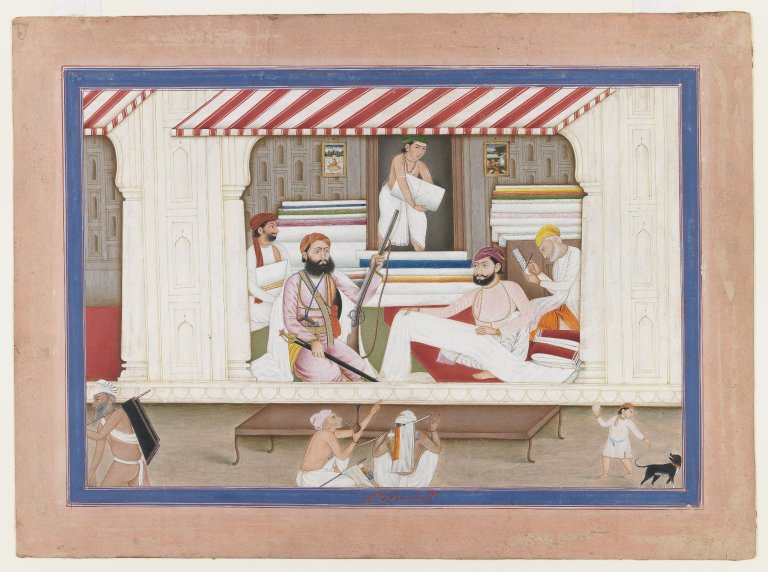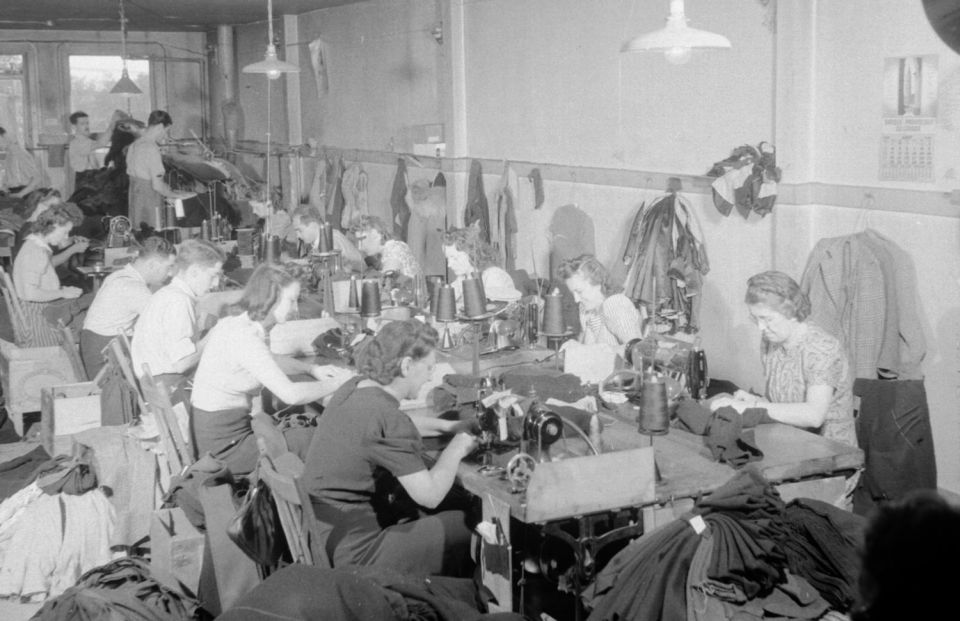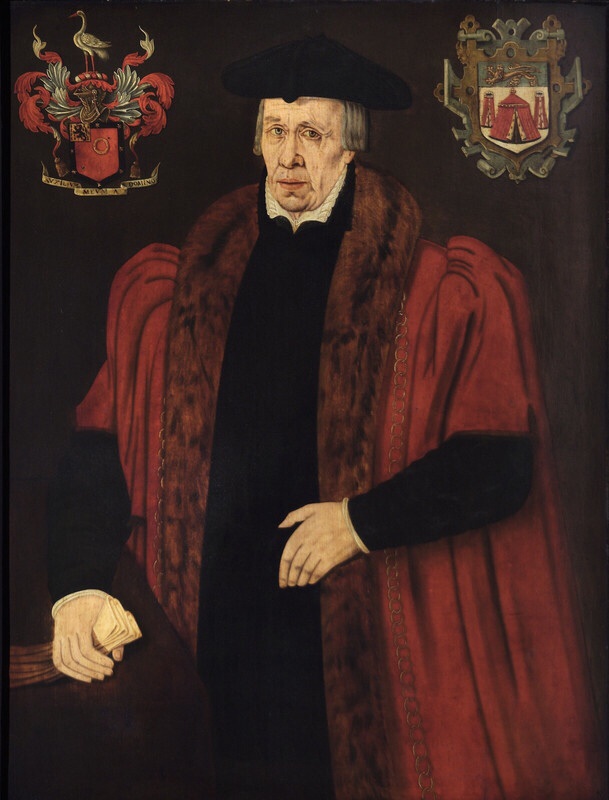|
Cloth Merchant
In the Middle Ages or 16th and 17th centuries, a cloth merchant was one who owned or ran a cloth (often wool) manufacturing or wholesale import or export business. A cloth merchant might additionally own a number of draper's shops. Cloth was extremely expensive and cloth merchants were often very wealthy. A number of Europe's leading banking dynasties such as Medici and Berenberg built their original fortunes as cloth merchants. In England, cloth merchants might be members of one of the important trade guilds, such as the Worshipful Company of Drapers. Alternative names are clothier, which tended to refer more to someone engaged in production and the sale of cloth, whereas a cloth merchant would be more concerned with distribution, including overseas trade, or haberdasher, who were merchants in sewn and fine fabrics (e.g. silk) and in London, members of the Haberdashers' Company. The largely obsolete term merchant taylor also describes a business person who trades in texti ... [...More Info...] [...Related Items...] OR: [Wikipedia] [Google] [Baidu] |
Brooklyn Museum - Cloth Merchant's Shop - Basarat
Brooklyn () is a borough of New York City, coextensive with Kings County, in the U.S. state of New York. Kings County is the most populous county in the State of New York, and the second-most densely populated county in the United States, behind New York County (Manhattan). Brooklyn is also New York City's most populous borough,2010 Gazetteer for New York State . Retrieved September 18, 2016. with 2,736,074 residents in 2020. Named after the Dutch village of , ... [...More Info...] [...Related Items...] OR: [Wikipedia] [Google] [Baidu] |
Sir William Gardiner, 1st Baronet
Sir William Gardiner, 1st Baronet (9 May 1628 – 23 June 1691) was an English politician who sat in the House of Commons in 1660. Gardiner was the son of Robert Gardiner of Wigan and his wife Mary Palmer. In 1660, Gardiner was elected Member of Parliament for Wigan in the Convention Parliament. He was made a Knight of the Bath at the coronation of King Charles II and was created Baronet of Roche Court in the same year on 2 December 1660. Gardiner died at the age of 63. Gardiner married Anne Brocas, daughter Robert Brocas of Beaurepaire, Hampshire, and had two sons Sir Brocas Gardiner, 2nd Baronet and Bernard Bernard ('' Bernhard'') is a French and West Germanic masculine given name. It is also a surname. The name is attested from at least the 9th century. West Germanic ''Bernhard'' is composed from the two elements ''bern'' "bear" and ''hard'' "bra .... References {{DEFAULTSORT:Gardiner, William 1628 births 1691 deaths People from Wigan English MP ... [...More Info...] [...Related Items...] OR: [Wikipedia] [Google] [Baidu] |
Clothing Industry
Clothing industry or garment industry summarizes the types of trade and industry along the production and value chain of clothing and garments, starting with the textile industry (producers of cotton, wool, fur, and synthetic fibre), embellishment using embroidery, via the fashion industry to apparel retailers up to trade with second-hand clothes and textile recycling. The producing sectors build upon a wealth of clothing technology some of which, like the loom, the cotton gin, and the sewing machine heralded industrialization not only of the previous textile manufacturing practices. Clothing industries are also known as allied industries, fashion industries, garment industries, or soft good industries. Terminology By the early 20th century, the industry in the developed world often involved immigrants in "sweat shops", which were usually legal but were sometimes illegally operated. They employed people in crowded conditions, working manual sewing machines, and being paid le ... [...More Info...] [...Related Items...] OR: [Wikipedia] [Google] [Baidu] |
Cloth Merchants
Textile is an Hyponymy and hypernymy, umbrella term that includes various Fiber, fiber-based materials, including fibers, yarns, Staple (textiles)#Filament fiber, filaments, Thread (yarn), threads, different #Fabric, fabric types, etc. At first, the word "textiles" only referred to woven fabrics. However, weaving is not the only manufacturing method, and many other methods were later developed to form textile structures based on their intended use. Knitting and Nonwoven, non-woven are other popular types of fabric manufacturing. In the contemporary world, textiles satisfy the material needs for versatile applications, from simple daily clothing to Bulletproof vest, bulletproof jackets, spacesuits, and Medical gown, doctor's gowns. Textiles are divided into two groups: Domestic purposes [consumer textiles] and technical textiles. In consumer textiles, Aesthetics (textile), aesthetics and Textile performance#Comfort, comfort are the most important factors, but in technical tex ... [...More Info...] [...Related Items...] OR: [Wikipedia] [Google] [Baidu] |
Retail
Retail is the sale of goods and services to consumers, in contrast to wholesaling, which is sale to business or institutional customers. A retailer purchases goods in large quantities from manufacturers, directly or through a wholesaler, and then sells in smaller quantities to consumers for a profit. Retailers are the final link in the supply chain from producers to consumers. Retail markets and shops have a very ancient history, dating back to antiquity. Some of the earliest retailers were itinerant peddlers. Over the centuries, retail shops were transformed from little more than "rude booths" to the sophisticated shopping malls of the modern era. In the digital age, an increasing number of retailers are seeking to reach broader markets by selling through multiple channels, including both bricks and mortar and online retailing. Digital technologies are also affecting the way that consumers pay for goods and services. Retailing support services may also include the prov ... [...More Info...] [...Related Items...] OR: [Wikipedia] [Google] [Baidu] |
Merchant
A merchant is a person who trades in commodities produced by other people, especially one who trades with foreign countries. Historically, a merchant is anyone who is involved in business or trade. Merchants have operated for as long as industry, commerce, and trade have existed. In 16th-century Europe, two different terms for merchants emerged: referred to local traders (such as bakers and grocers) and ( nl, koopman) referred to merchants who operated on a global stage, importing and exporting goods over vast distances and offering added-value services such as credit and finance. The status of the merchant has varied during different periods of history and among different societies. In modern times, the term ''merchant'' has occasionally been used to refer to a businessperson or someone undertaking activities (commercial or industrial) for the purpose of generating profit, cash flow, sales, and revenue using a combination of human, financial, intellectual and physical capita ... [...More Info...] [...Related Items...] OR: [Wikipedia] [Google] [Baidu] |
Le Bourgeois Gentilhomme
''Le Bourgeois gentilhomme'' (, translated as ''The Bourgeois Gentleman'', ''The Middle-Class Aristocrat'', or ''The Would-Be Noble'') is a five-act ''comédie-ballet'' – a play intermingled with music, dance and singing – written by Molière, first presented on 14 October 1670 before the court of Louis XIV at the Château of Chambord by Molière's troupe of actors. Subsequent public performances were given at the theatre of the Palais-Royal beginning on 23 November 1670. The music was composed by Jean-Baptiste Lully, the choreography was by Pierre Beauchamp, the sets were by Carlo Vigarani and the costumes were done by the chevalier d’Arvieux. ''Le Bourgeois gentilhomme'' satirizes attempts at social climbing and the bourgeois personality, poking fun both at the vulgar, pretentious middle-class and the vain, snobbish aristocracy. The title is meant as an oxymoron: in Molière's France, a "gentleman" was by definition nobly born, and thus there could be no such thi ... [...More Info...] [...Related Items...] OR: [Wikipedia] [Google] [Baidu] |
Thomas White (merchant)
Sir Thomas White (1492 – 12 February 1567) was an English cloth merchant, Lord Mayor of London in 1553, and a civic benefactor and founder of St John's College, Oxford. Biography Thomas White was born in Reading, Berkshire, the son of William White, a clothier of Reading, and his wife, Mary, daughter of John Kibblewhite of South Fawley, also in Berkshire. He was brought up in London. Sir Thomas was twice married, to Avicia (died 1558) and to Joan. A principal member of the guild of Merchant Taylors, he served as Sheriff of London in 1547, and was elected Lord Mayor of London in 1553. He was knighted in the same year by Queen Mary I. He was a member of the commission for the trial of Lady Jane Grey. In 1555, inspired by the example of Thomas Pope, founder of Trinity College, Oxford, White obtained a royal licence for the foundation of St John's College, Oxford, dedicated to the patron saint of the Merchant Taylors and established in the buildings of the dissolved Cis ... [...More Info...] [...Related Items...] OR: [Wikipedia] [Google] [Baidu] |
Thomas Spring Of Lavenham
Thomas Spring (c. 1474 – 1523), (''alias'' Thomas Spring III or The Rich Clothier), of Lavenham in Suffolk, was an English cloth merchant.Phil W Kaufman, ''American Traces in Anglian Places'' (Lulu.com), 19. He consolidated his father's business to become one of the most successful in the booming wool trade of the period and was one of the richest men in England.The Cloth Industry of Lavenham Retrieved 25 April 2013. Origins Thomas III Spring was the eldest son and heir of Thomas II Spring (died 7 September 1486). of Lavenham (whose monumental brass survives in Lavenham Church), by his wife Margaret Appleton. His father's will mentions Thomas and tw ...[...More Info...] [...Related Items...] OR: [Wikipedia] [Google] [Baidu] |
William Paterson (banker)
Sir William Paterson (April 1658 - 22 January 1719) was a Scottish trader and banker. He was one of the founders of the Bank of England and was one of the main proponents of the catastrophic Darien scheme. Later he became an advocate of Union with England. Biography Early life William Paterson was born in his parents' farmhouse at Tinwald in Dumfriesshire, Scotland, and lived with them until he was seventeen, when he emigrated first (briefly) to Bristol and then to the Bahamas, although accounts differ as to the duration of his stays. During his time in the West Indies he first conceived the idea of the Darién scheme, his plan to create a colony on the isthmus of Panama, facilitating trade with the Far East. While in the West Indies, it is said that he acted as a merchant, developing a reputation for business acumen and dealings with local buccaneers. Career Paterson returned to Europe by the middle of the 1680s, and attempted to convince the English government under ... [...More Info...] [...Related Items...] OR: [Wikipedia] [Google] [Baidu] |
Jack O'Newbury
"Jack of Newbury" or John Winchcombe, also known as John Smallwood (c. 1489 −1557) was a leading English clothier from Newbury in Berkshire. When Tudor cloth-making was booming, and woollen cloth dominated English exports, John Winchcombe was producing for export on an industrial scale. He was a leading clothier in other ways. Cloth-making was heavily regulated, and in the 1530s and 1540s Winchcombe led dozens of clothiers in a national campaign to persuade King Henry VIII to change the law on the making of woollen cloth – a campaign which proved ultimately successful. He was the son of a clothier, but became a clothier in his own right before his father's death in 1520, and combined the two businesses, taking on property which had been leased to his father. He was already wealthy in the 1520s, and his growing prosperity led to a significant rise in his status. Wealth and Property Winchcombe became a wealthy landowner, spending over £4,000 on the purchase of property ... [...More Info...] [...Related Items...] OR: [Wikipedia] [Google] [Baidu] |
Henry Machyn
Henry Machyn (1496/1498 – 1563) was an English clothier and diarist in 16th century London. Machyn's ''Chronicle'', which was written between 1550 and 1563, is primarily concerned with public events: changes on the throne, state visits, insurrections, executions and festivities. Machyn wrote his diary during a turbulent period in England: the Reformation, initiated by Henry VIII and carried through by Edward VI, was followed by the return to Catholicism (and burning of heretics) under Queen Mary I of England. Judging from his enthusiastic account of the disinterment of Edward the Confessor in 1557, Machyn was apparently a Catholic himself. The brief reign of Lady Jane Grey, and the dangers of speaking up for the losing side, are duly recorded. He circulated libellous information about the Protestant preacher John Véron John Véron (d. 1563) was a French Protestant controversialist and preacher, known for his activities in England. Veron also served as an English translat ... [...More Info...] [...Related Items...] OR: [Wikipedia] [Google] [Baidu] |








